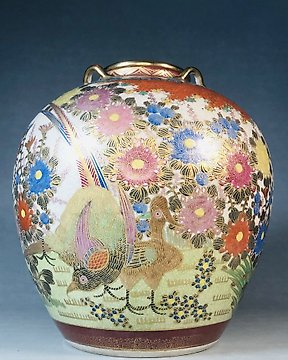
Wazon - Wazon przedstawiający ptaki, różne kwiaty, domy i góry wykonany około 50-80 lat temu - Japonia (Bez ceny minimalnej )
Nr 83683613

Nr 83683613

This is a set of Hanakanzashi 花簪 (Flower hairpin), Comb and Hair Ornaments.
A "kanzashi" is a traditional Japanese hair ornament, primarily worn by women when donning traditional Japanese attire such as kimono. Historically, they have been used in ceremonies, festivals, and other special occasions, but today, they are mainly seen at festivals and weddings.
Kanzashi are crafted from materials like wood, bamboo, ivory, and metal, often adorned with lacquer or decorative elements. They come in a wide variety of designs, featuring carvings of flowers, birds, animals, plants, geometric patterns, and intricate coloring.
Traditional Japanese hairstyles come in various styles, each with its own way of using and inserting kanzashi. For instance, in the "odango" hairstyle, kanzashi are inserted at the top to secure the gathered hair and enhance its decorative effect. Kanzashi may also be inserted in the front to accentuate the facial contours or used to secure the hair when it is gathered at the back.
In recent years, there has been a trend of incorporating kanzashi not only with traditional Japanese attire but also with Western clothing. Particularly at weddings and formal events, there is a growing interest in blending Japanese and Western styles.
From around the Azuchi-Momoyama period, the hairstyle of women transitioned to "katsuyama" (a way of arranging the hair), and gradually, hairpins began to be used as items of "beauty." The influence of onnagata (male actors specializing in female roles) in kabuki and Agou of Izumo imitating young men by tying their hair into a mage (topknot) is said to have played a role in this change.
During the mid-Edo period, various types of hairpins were born with the development of Nihongami (traditional Japanese hairstyles). Hairpins reached their peak popularity in the late Edo period, introducing flowerpins, ballpins, flutteringpins, and flatpins.
Hairpins can be broadly categorized into single-shaft and double-shaft types. The single-shaft type is considered a classic, enhancing the brilliance when inserted into hair tied in styles like odango (buns). The double-shaft type, as the name suggests, has two shafts.
While the popularity of hairpins declined as Japanese hairstyles transitioned to Western hairstyles, they still maintain a strong following as accessories that complement not only traditional Japanese attire but also Western-style clothing.
Condition:
This is a used item. Some are in good condition and some are not so good. The items listed back the first photo are not in good condition. Items that are not good have small damages. A long, thin stick and a comb. Please handle with care as it is delicate and fragile. It was stored at home for a long time. I have posted a lot of photos, so please take a look.
Atention:
The items listed for sale are all used collectibles. Please consider them to have signs of aging, such as stains, scratches, scuffs, tears, discoloration, fading, fraying, and changes in thread color. We will post as many photos as possible to make it easy to understand. As these are old items, we appreciate your understanding before making a purchase.
Shipping:
The lot will be carefully packaged and shipped from Japan.
We will use either DHL or FedEx for a safe and secure transportation. It usually takes about 2-3 weeks for delivery, and the package will be shipped with a tracking number.
Import duties, taxes, VAT, and any other charges are not included in the item price and shipping cost. Please check your country's import duties before bidding.
022221070502
Jak kupować w serwisie Catawiki
1. Odkryj coś wyjątkowego
2. Złóż najwyższą ofertę
3. Dokonaj bezpiecznej płatności